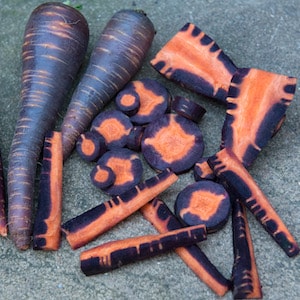What to do in your allotment in March
Written by Lee Senior
March is an exciting month in the horticultural calendar, as it’s the beginning of the main seed sowing period. Across the country, allotment sites are gradually waking up from their winter slumber in anticipation of the exciting new season ahead. Sunshine has been in short supply so far and soil temperatures are still cold, yet despite this, spring is almost in the air! Rhubarb is growing steadily, spring bulbs are flowering and the gardener’s favourite edible weed, the humble dandelion, is once again making an appearance.
There are many vegetables that can be started in gentle heat this month, but only sow your seeds if you can provide the correct conditions for growing on. If you’re lucky to have access to an unheated greenhouse or polytunnel, early potatoes can be planted now in containers and grown on to maturity. Protect the young shoots and subsequent growth from frost, which remains a risk even under cover. I use frost protection fleece but, if you don’t have any to hand, thick layers of cardboard, newspaper or temporary sheeting will also work. Happy growing!
Allotment flowers in March
- Summer-flowering bulbs like gladioli can be planted this month.
- Lilies, although often planted in autumn, can also be planted in early spring. If you’re using containers, move the bulbs out onto the allotment when they’ve finished flowering for future years.
- Half-hardy and hardy bedding plant seeds can be sown in a heated propagator or on the windowsill this month. Protect half-hardy seedlings from frost with fleece or gentle heat until the end of May.
- Bedding plug plants, which can be ordered now, make a great alternative to growing from seed if space or time is limited.
- This month, colourful crocus flowers linger on and are supplemented by daffodils and muscari. Snap the spent heads from daffodils to maintain their vigour by preventing them from setting seed.
- There are a number of miniature daffodils, perfect for containers. I like the dwarf variety ‘Tete a Tete’. For something different try the double-flowered, multi-petalled, ‘Rip Van Winkle’.
- The blue muscari ‘Armeniacum’ looks great under trees or in semi-shaded areas and flowers towards the end of March into April.
- Sow sunflower seeds into modular seed trays and pop them on a sunny windowsill to germinate ready for potting-on next month.
- Lime-haters such as azaleas, camellias and rhododendrons should be fed this month with a slow-release ericaceous fertiliser.
Allotment vegetables in March
- There’s still time to plant a few garlic bulbs to provide a respectable crop at the end of summer.
- I like to start off my spring-planting onion sets in a cold greenhouse at the beginning of this month. The root development is quicker than direct planting at this time of year.
- Broad bean seeds and early peas can be sown under cover this month. Cabbage, cauliflower, lettuce, Brussels sprouts, early carrots, peppers and tomato seeds can be sown too.
- I prefer to sow early pea seeds in gentle heat indoors and then transplant later in spring. The second early variety Pea ‘Hurst Greenshaft’ is ideal.
- Sow Brussels sprouts F1 ‘Brenden’ or F1 ‘Crispus’ in a cold greenhouse or on the windowsill.
- From the middle of March, make some early carrot seed sowings to help to avoid carrot fly. Only sow seeds in pre-warmed soil, or sow in a polytunnel.
- I’m a huge fan of purple carrots and my kids love them too. At the end of the month and into April, direct sow F1 ‘Purple Haze’ into well-drained, freshly prepared ground that has been pre-warmed with a membrane.
- Lettuce ‘Unrivalled’ is perfect for spring sowing in trays for transplanting. At this time of year I sow under glass but as the soil warms up the seeds can be sown directly.
- Courgettes are one of my favourite crops. They have many uses and are easy to grow. Sow the seed in March and April in gentle heat and protect from frost.
- Parnsip seeds can be directly sown from the end of March through to late April, depending on ground conditions. Pre-cover the soil with black sheeting to warm it up before sowing as parsnips are notoriously slow and erratic to germinate if the soil is too cold. Only choose soil that is largely free of major stones or soil pans. Try interspersing the parsnip seed with faster maturing radish in the same seed drill. This helps to mark the row and provide a useful catch crop.
- In a heated propagator, sow Cucumber F1 ‘Delistar’.
- At the end of the month, early Beetroot ‘Boltardy’ can be direct-sown.
- Sweet corn needs a relatively long season and seed should be sown in March in gentle heat. Take care not to overwet the compost as the seeds can be prone to rot. Protect from frost.
- In mild areas, early varieties of chitted potatoes can be planted in well-drained ground. If the soil is too wet or cold, wait until April if necessary. Alternatively, early varieties work well in larger containers and can mature within 10-12 weeks. They grow well in greenhouses and polytunnels if it isn’t too hot, but please do keep an eye out for frost.
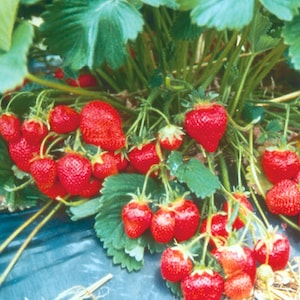
Image: Strawberry Plants Marshmello
Allotment fruit in March
- Blueberries are a super fruit to grow. Unless your soil is naturally acidic, plant the bushes in large pots of ericaceous compost.
- If you want to grow blackberries but are worried about the spines, there are a good number of thornless varieties around these days. ‘Apache‘ produces large, sweet and juicy berries.
- Bare rooted gooseberries and all currant plants including whitecurrants, redcurrants and blackcurrants can be planted out until the end of March if the soil isn’t frozen or waterlogged.
- Pot-grown fruit trees can be planted all year round.
- Keep a watchful eye out for frost if you have apricot, nectarine or peach trees on your allotment. The blossom of these trees comes out particularly early, thus making it especially susceptible to frost. Always have winter grade fleece on standby to cover the blossom at short notice. Severe frost damage to the blossom can result in a poor crop. Alternatively, if you’re lucky enough to have the space, why not grow a dwarf variety like ‘Yellow Peach’ in a pot in a polytunnel, like my neighbour does?
- Prune established autumn-fruiting raspberries almost to ground level before new growth commences.
- Clear out any dead strawberry plant foliage to encourage a good air flow to the base of the crowns.
- I’ve been adding well-rotted manure to all my established fruit beds, including strawberries, raspberries and currents as well as my established fruit trees. All are gross feeders and benefit from extra nutrients now as they start to wake up from their winter dormancy.
Crops to harvest in March
- Purple sprouting broccoli is now cropping heavily and the young heads are so full of flavour. Use netting to protect your plants if pigeons are a problem.
- Kale, winter cabbage, Jerusalem artichokes and spring onions are in season.
- You can still get good crops of winter lettuce, under glass.
- I’ve now run out of leeks after a bumper crop, but I plan to sow even more this year to remedy this.
- My Brussels sprouts have just about finished now and what a wonderful crop it has been! The flavour of modern varieties is far superior and less bitter than older varieties.
- Parsnips are still going strong but it’s noticeable the tops are starting to grow just a little. When this happens they should be okay for another two-to-three weeks before they start to become unusable.
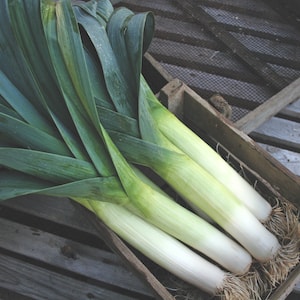
Image: Leek Seeds – F1 Below Zero
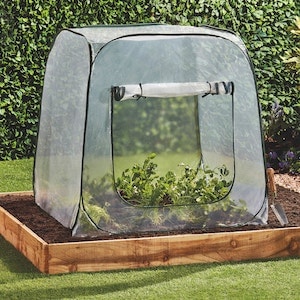
Image: Pop Up Garden Cloche
General March allotment jobs
- Try to stay off waterlogged soil but, if you have to access the allotment, use planks to spread your weight.
- If you’re transplanting seedlings this month be careful to handle them by the leaves and avoid contact with the stem. Damage to the stem is irreparable whereas a damaged leaf is not so calamitous.
- Prepare your raised beds for direct sowing seeds at the end of March. Cover the ground with black plastic to warm the soil underneath.
- Invest in some cloches to advance outdoor sowing and improve the germination rates of outdoor sown seeds.
- Remember to carefully dispose of any spent winter crop plants. If they show any signs of disease like club root, don’t add them to the compost heap or you’ll spread disease around the allotment.
- Prepare all your beds for planting by digging in some good quality compost. If you use well-rotted manure, make sure it’s properly rotted down so it doesn’t damage the delicate roots of your seedlings.
- Perennial weeds and couch grass are already starting to grow and of course heavyweight weeds such as ground elder. I like to remove as many young perennial weeds and couch grass now to save time later in the year.
- If it’s still very cold in your area, you could always insulate your greenhouse with horticultural bubble wrap. Or, invest in some fleece to cover seedlings.
- Protect your containers from impending slug and snail attack with copper tape.
- Put a feeder out for the birds to attract them to your allotment. Birds eat pests and should be a welcome sight around the plot.
- Use shading fabric in the greenhouse if the weather’s unseasonably sunny and warm. This protects seedlings from sun scorch.
Planning ahead
- Plan to start watering next month by cleaning or installing water buts and checking watering cans.
- Check you have plenty of potting compost and containers for potting on all your thriving plants and seedlings in April.
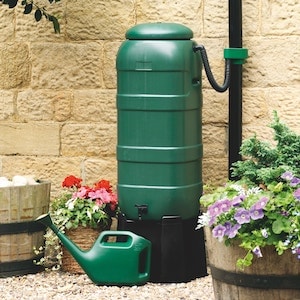
Image: Suttons
Suttons Seeds recommend these areas which may also be of interest.
- Previous month: What to do in your allotment in February
- Next month: What to do in your allotment in April



